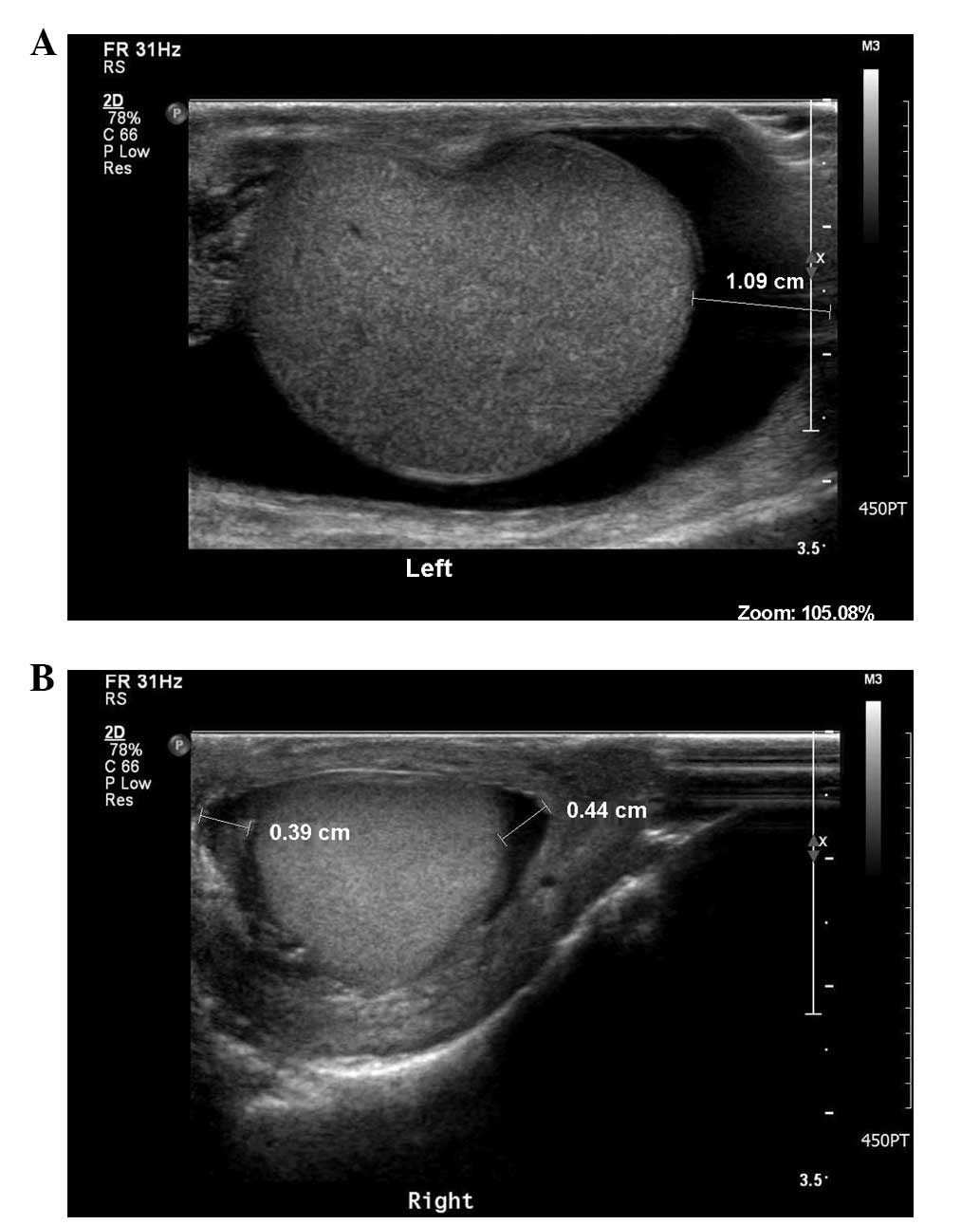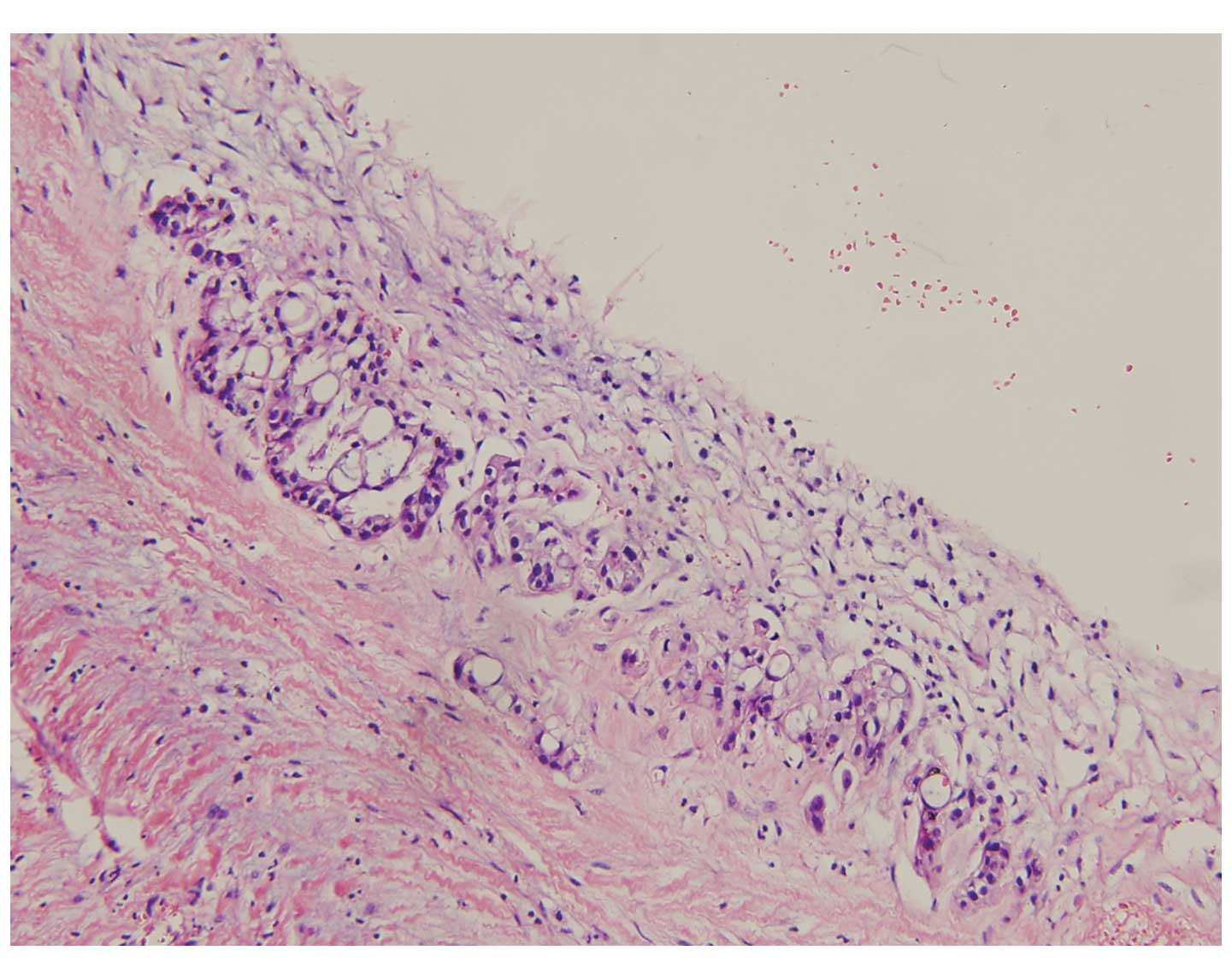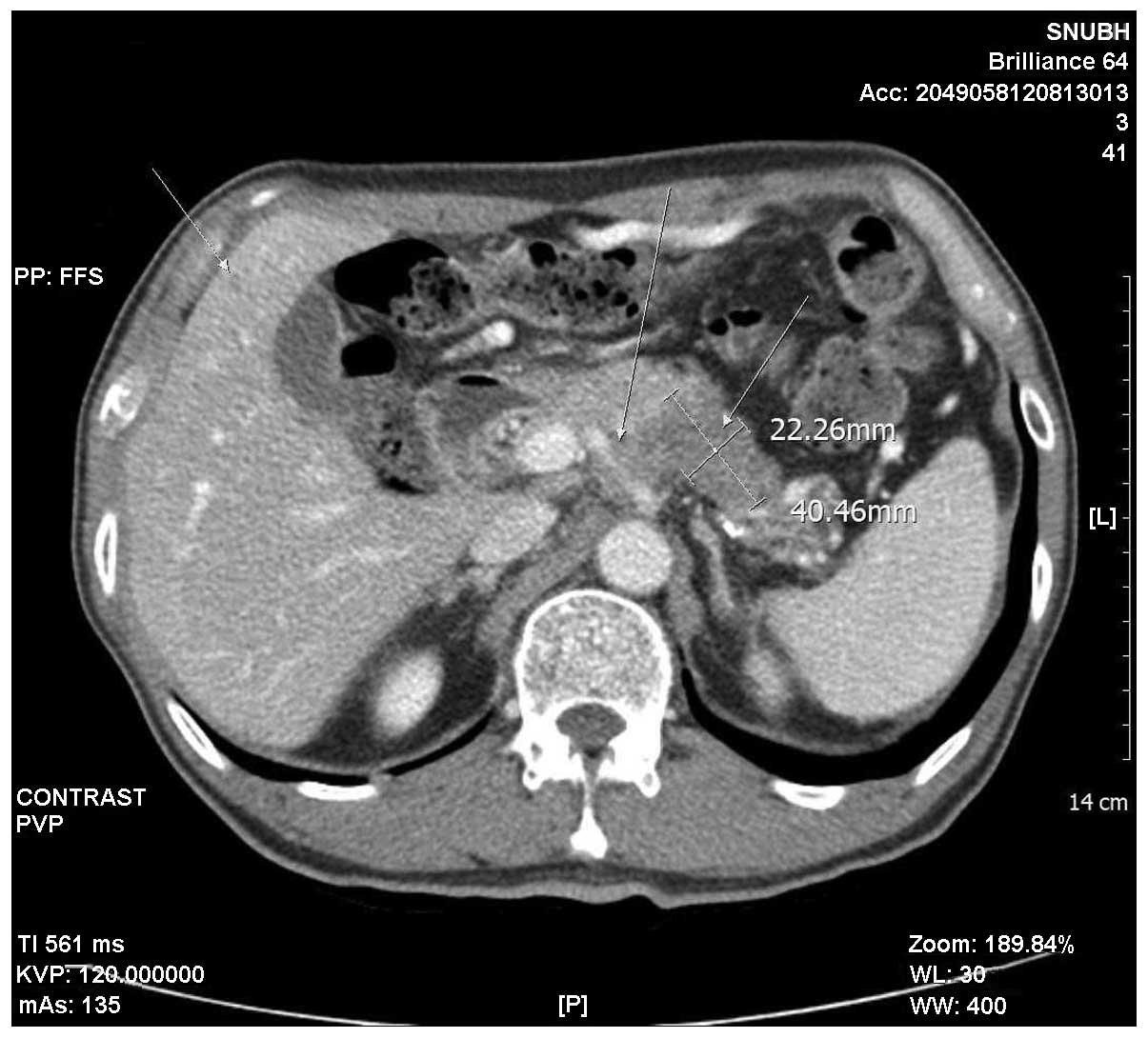Introduction
Metastatic testicular tumors that are formed from
another solid tumor origin are relatively uncommon. Malignant
tumors are known to account for 32.9% of testicular tumors, and
metastatic tumors are reported to account for only 6–8% of the
malignant tumors (1–2). The most common primary sites reported
are the prostate, kidney, lung and gastrointestinal tract (1–3). Only
a few cases of metastatic pancreatic carcinoma of the testis have
been reported, in which the initial manifestation was a painful
scrotal swelling or scrotal mass (3–6).
The present study reports a case of metastatic
adenocarcinoma spreading from the pancreas to the testes, which
initially presented as a painful scrotal swelling. Written informed
consent was obtained from the patient.
Case report
A 69-year-old male admitted to Seoul National
University Bundang Hospital (Seongnam, Korea) presented with a
painful swelling in the left scrotum, which was gradually
increasing in size. The patient had no history of trauma, no
medical history of genitourinary tract anomalies or complaints and
did not exhibit any other subjective symptoms.
A physical examination using transillumination
revealed a soft, tender mass in the left scrotum and edematous
swelling of the surrounding tissue. There were no abnormal findings
in the abdomen, chest or extremities. The complete blood cell
count, liver function test and serum electrolyte and serum
creatinine levels were all within the normal range.
Scrotal ultrasonography showed a large amount of
fluid collection in the left scrotal sac, a small amount of fluid
with internal echogenic material in the right scrotal sac and
diffuse swelling of the scrotal epithelia. The sonographic findings
were consistent with a hydrocele of the left testis, a smaller
hydrocele of the right testis and associated inflammatory changes
in the surrounding soft tissue (Fig.
1).
A left hydrocelectomy was performed with the
presumptive diagnosis of a benign hydrocele. The pathological
diagnosis was consistent with metastatic adenocarcinoma (Fig. 2).
Immunohistochemical staining showed that the tumor
cells were positive for cytokeratin 7 and were negative for
cytokeratin 20, thyroid transcription factor-1, prostate-specific
antigen, estrogen receptor and calretinin.
Following the diagnosis of metastatic cancer,
several examinations were performed to detect the primary cancer.
Abdominal-pelvic computerized tomography demonstrated a
low-attenuating mass (4.0×2.2 cm) in the pancreatic tail encasing
the common hepatic artery. Multiple scattered lesions in the liver,
nodular infiltrates in the omentum and peritoneal thickening in the
pelvic region were also found, indicating pancreatic tail cancer
with liver and multiple lymph node metastasis and peritoneal
carcinomatosis (Fig. 3). Whole-body
positron emission tomography demonstrated hypermetabolic lesions in
the right liver, retropancreatic area, left scrotum and distal
pancreas. Tumor marker studies revealed an increased level of
cancer antigen 19-9 (4,900 U/ml vs. the normal range of <37
U/ml), whereas the levels of β-human chorionic gonadotropin,
lactate dehydrogenase, α-fetoprotein, carcinoembryonic antigen and
prostate-specific antigen were in the normal range.
On the basis of these findings, the patient was
diagnosed as having pancreatic cancer with metastasis to the liver,
peritoneum, lymph nodes and testes. The patient received 3 cycles
of gemcitabine-based chemotherapy but resulted in progressive
disease. No further chemotherapy was available due to general
deconditioning and palliative care was provided.
Discussion
Metastatic testicular tumors originating from
pancreatic cancer are rare. In total, <20 cases have been
reported, and it is known that the right testis is more commonly
involved (3–6).
Although the current patient first presented with
left scrotal swelling without any other symptoms, imaging studies
showed hydroceles of the testes, with the hydrocele of the left
testis being larger in size. A left hydrocelectomy was performed,
as the patient had symptoms only in the left side. However,
considering the final diagnosis of metastatic pancreatic cancer and
the large extent of the disease, tumor formation in the right
testis was suspected also. The treatment plan for the right testis
was systemic chemotherapy considering the origin of the metastatic
tumor. To the best of our knowledge, this is the first case of
metastatic pancreatic adenocarcinoma involving the left and right
testes.
Invasion of the testes and paratesticular organs by
a metastatic epithelial malignant tumor is rarely the initial
clinical manifestation of a primary tumor and may occur as a part
of a widely disseminated disease, indicating a poor prognosis with
a survival of only 9.1 months from the time of diagnosis (2). The most common primary sites are the
prostate, lung, kidney and colon, and less common sites are the
stomach, ileum, appendix and pancreas (1–3).
Several routes of metastasis to the testicular
tissues have been proposed. These pathways include direct invasion
from the contiguous lesion, retrograde venous or arterial embolism,
retrograde lymphatic extension from the paraaortic lymph nodes,
transperitoneal seeding through a congenital hydrocele and
retrograde extension from the vas deferens (1,3,7).
Numerous cases appear to reinforce the idea of retrograde lymphatic
spread. In the present case, the suspected route of tumor spread
was lymphatic and hematogenous, considering metastases of the
paraaortic lymph nodes and the liver. However, there was a
possibility of transperitoneal seeding through a congenital
hydrocele, when considering the painful hydrocele as the first
presentation and the extent of the diffuse peritoneal
carcinomatosis.
As observed in the current case, metastatic
adenocarcinomas of the pancreas, particularly carcinomas of the
pancreatic tail, reveal late or no definite clinical symptoms
associated with the original tumor. The prognosis of this type of
cancer is unfavorable in the majority of cases. In total, <1% of
the patients with metastatic pancreatic cancer will survive 5 years
following diagnosis (8,9).
The current case indicates that possible metastatic
disease should be suspected in patients presenting with a
testicular mass or swelling at an age in which a primary testis
tumor is unlikely. Such patients should undergo an extensive
metastatic evaluation as well as a standard evaluation for a
primary testis tumor, particularly if the clinical findings
indicate the involvement of other organs (8,10).
References
|
1
|
Haupt HM, Mann RB, Trump DL and Abeloff
MD: Metastatic carcinoma involving the testis. Clinical and
pathologic distinction from primary testicular neoplasms. Cancer.
54:709–714. 1984. View Article : Google Scholar
|
|
2
|
Algaba F, Santaularia JM and Villavicencio
H: Metastatic tumor of the epididymis and spermatic cord. Eur Urol.
9:56–59. 1983.PubMed/NCBI
|
|
3
|
Seo IY, Kim SG, Han WC and Rim JS:
Paratesticular mucinous cystadenocarcinoma: metastasis from
pancreatic cancer. Int J Uro. 11:1147–1149. 2004. View Article : Google Scholar : PubMed/NCBI
|
|
4
|
Sawa TE, Duun S and Andersen JT:
Paratesticular tumor: a metastasis from primary pancreas cancer.
Scand J Urol Nephrol. 34:70–71. 2000. View Article : Google Scholar : PubMed/NCBI
|
|
5
|
Dookeran KA, Lotze MT, Sikora SS and Rao
UN: Pancreatic and ampullary carcinomas with intrascrotal
metastasis. Br J Surg. 84:198–199. 1997. View Article : Google Scholar : PubMed/NCBI
|
|
6
|
Tanaka H, Yasui T and Watase H: Metastatic
tumor of the epididymis from pancreatic carcinoma: a case report.
Hinyokika Kiyo. 45:649–652. 1999.(In Japanese).
|
|
7
|
Meares EM Jr and Ho TL: Metastatic
carcinomas involving the testis: a review. J Urol. 109:653–655.
1973.PubMed/NCBI
|
|
8
|
Rosser CJ and Gerrard E: Metastatic
adenocarcinoma of the pancreas to the testicle: a case report. Am J
Clin Oncol. 22:619–620. 1999. View Article : Google Scholar : PubMed/NCBI
|
|
9
|
Whipple AO, Parsons WB and Mullins CR:
Treatment of carcinoma of the ampulla of vater. Ann Surg.
102:763–779. 1935. View Article : Google Scholar : PubMed/NCBI
|
|
10
|
Salesi N, Fabi A, Di Cocco B, et al:
Testis metastasis as an initial manifestation of an occult
gastrointestinal cancer. Anticancer Res. 24:1093–1096.
2004.PubMed/NCBI
|

















